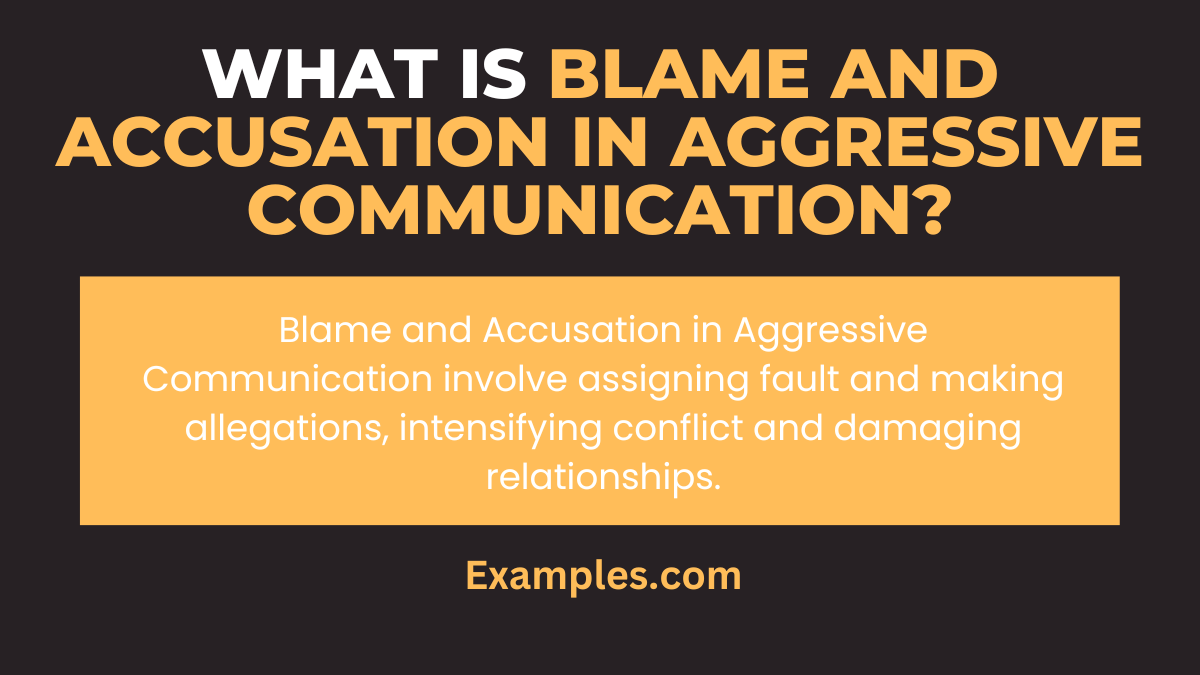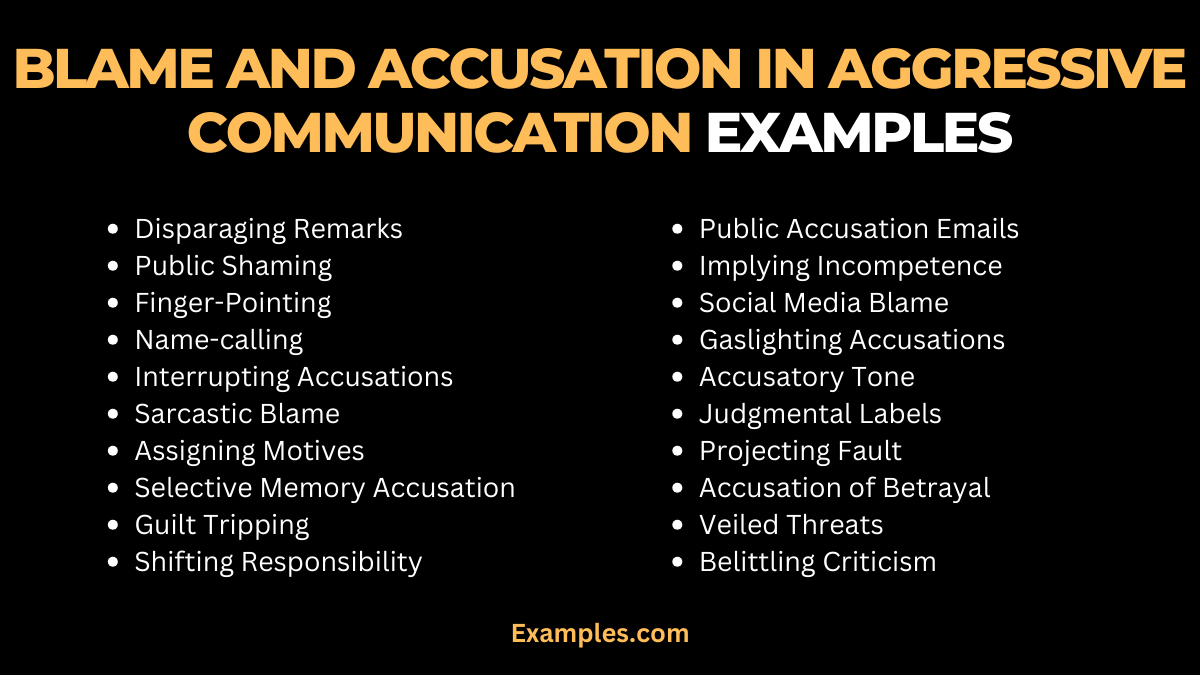19+ Blame and Accusation in Aggressive Communication Examples
Embark on a comprehensive exploration of Blame and Accusation in Aggressive Communication, delving into the intricate dynamics that shape interpersonal interactions. This complete guide unveils real-life scenarios, providing invaluable insights and practical strategies for navigating blame and accusation effectively. Enhance your communication prowess with illustrative communication examples that illuminate the nuances of this challenging aspect, empowering you to foster constructive dialogue and minimize conflicts.
What is Blame and Accusation in Aggressive Communication?

Blame and accusation in aggressive communication refer to the act of assigning fault or guilt to others in a confrontational manner. It involves pointing fingers, making allegations, and placing responsibility on individuals, often intensifying conflicts. In this context, blame and accusation serve as aggressive tools, impacting the dynamics of communication by fostering hostility and creating an adversarial atmosphere. Understanding these elements is crucial for navigating assertive expression without escalating into outright aggression.
What is the Best Example of Blame and Accusation in Aggressive Communication?

In a workplace scenario, imagine a team meeting where a project deadline is missed. Instead of fostering a collaborative problem-solving approach, a team member aggressively points at a colleague, accusing them of incompetence and blaming them for the setback. The accuser employs harsh language and assigns sole responsibility, fueling resentment. This example illustrates how blame and accusation, when wielded aggressively, hinder teamwork, damage relationships, and impede constructive communication, emphasizing the need for a more collaborative approach.
20 Blame and Accusation in Aggressive Communication Examples

Discover the intricate dynamics of blame and accusation within aggressive communication through these 20 examples. Gain valuable insights into how these behaviors manifest in various scenarios, impacting relationships and communication. Each example is accompanied by a concise explanation and illustrative sentences to deepen your understanding. Explore these instances to enhance your awareness and develop strategies for fostering healthier dialogue in challenging situations.
- Disparaging Remarks: Expressing criticism with derogatory language, fostering resentment. Example: “Your incompetence is dragging the whole team down.”
- Public Shaming: Accusing someone in a group setting, amplifying humiliation and stress. Example: “Look, everyone, at who’s responsible for our failure.”
- Finger-Pointing: Physically pointing while assigning blame, intensifying confrontation. Example: “This is your fault; you can’t escape it.”
- Name-calling: Using insults during an argument, damaging relationships. Example: “You’re nothing more than a lazy underachiever.”
- Interrupting Accusations: Constantly interrupting to forcefully blame without allowing a response. Example: “Don’t bother explaining; I already know it’s your fault.”
- Sarcastic Blame: Veiling blame with sarcasm, creating a hostile undertone. Example: “Bravo! Another brilliant move, as expected.”
- Assigning Motives: Accusing someone of malicious intent without evidence, aggravating conflict. Example: “You deliberately sabotaged the project.”
- Selective Memory Accusation: Blaming based on selective recall, distorting facts. Example: “You conveniently forgot your commitments again.”
- Guilt Tripping: Manipulating emotions to make someone feel guilty, intensifying blame. Example: “I hope you’re proud of what you’ve done to us.”
- Shifting Responsibility: Blaming others to deflect attention from personal shortcomings. Example: “I wouldn’t be in this mess if it weren’t for you.”
- Public Accusation Emails: Sending accusatory emails to a wider audience, causing embarrassment. Example: “Let me copy everyone to show who’s accountable here.”
- Implying Incompetence: Subtly insinuating incompetence without direct accusations. Example: “I thought hiring professionals meant getting the job done.”
- Social Media Blame: Using public platforms to shame and blame, risking reputation damage. Example: “Everyone needs to know what I’ve had to deal with.”
- Gaslighting Accusations: Manipulating someone into questioning their reality during blame. Example: “You’re imagining things; I never said that.”
- Accusatory Tone: Adopting a harsh tone while placing blame, escalating aggression. Example: “Clearly, you have no idea what you’re doing.”
- Judgmental Labels: Labeling someone negatively during an argument, fostering negativity. Example: “You’re just a quitter, plain and simple.”
- Projecting Fault: Projecting personal failures onto others, evading accountability. Example: “You’re always deflecting; face your own issues.”
- Accusation of Betrayal: Accusing someone of betrayal without evidence, straining relationships. Example: “I trusted you, and you stabbed me in the back.”
- Veiled Threats: Employing indirect threats while assigning blame, creating fear. Example: “Think twice before crossing me again.”
- Belittling Criticism: Criticizing and belittling someone’s efforts during blame, eroding self-esteem. Example: “Your contributions are laughable at best.”
Blame and Accusation in Aggressive Communication Examples in Real Life
Navigating blame and accusation in real-life scenarios demands a nuanced approach. Explore these instances to understand how such behaviors unfold in everyday situations.
- Family Dispute: During a disagreement, one family member blames another for familial issues, intensifying emotional tensions.
- Friendship Fallout: Blaming a friend for personal failures, damaging the friendship with accusatory language and resentment.
- Neighborhood Conflict: Accusing a neighbor of causing disturbances, leading to strained relations and escalated disputes.
- Romantic Relationships: In a relationship, one partner constantly blames the other, creating a toxic atmosphere of resentment.
- Social Gathering Tensions: Blaming someone for a social faux pas, escalating a minor issue into a confrontation.
Blame and Accusation in Aggressive Communication Examples in Workplace
Explore workplace scenarios where blame and accusation can jeopardize professional relationships and hinder productivity.
- Project Failure Blame: After a project fails, team members blame each other for the shortcomings, fostering a hostile work environment.
- Missed Deadline Accusation: Assigning blame for missed deadlines, affecting team morale and collaboration.
- Performance Review Accusation: Blaming colleagues during performance reviews, leading to animosity and reduced teamwork.
- Credit Stealing: Accusing a coworker of stealing credit for ideas, causing resentment and diminishing teamwork.
- Communication Breakdown Blame: When communication falters, team members blame each other for misunderstandings, hindering collaboration.
How Do Blame and Accusation Manifest in Aggressive Communication?
Blame and accusation often manifest through direct verbal attacks, where individuals use accusatory language to criticize or demean others. Aggressive communicators may deflect responsibility by shifting blame onto others, avoiding accountability for their actions.
- Verbal Attacks: Aggressive communication frequently involves direct verbal attacks, utilizing accusatory language to criticize or belittle others.
- Deflecting Responsibility: Individuals resort to blaming others and deflecting responsibility, avoiding accountability for their own actions and choices.
- Negative Language: Excessive use of negative language, such as blame-filled statements and accusations, characterizes aggressive communication patterns.
- Personal Attacks: Aggressive individuals may resort to personal attacks, blaming others for perceived flaws or mistakes.
- Interrupting and Dominating Conversations: Constant interruption and domination of conversations can be a subtle form of blame, implying others’ opinions are less valid.
What Are the Consequences of Excessive Blame and Accusation in Aggressive Communication?
Excessive blame erodes trust and damages relationships, creating hostility and resentment among individuals. In professional settings, constant accusations can lead to a toxic work environment, hindering collaboration and reducing overall productivity.
- Damaged Relationships: Frequent blame erodes trust and damages relationships, creating a hostile and resentful atmosphere.
- Reduced Productivity: In professional settings, constant accusations can lead to a toxic work environment, hindering collaboration and reducing overall productivity.
- Emotional Distress: Individuals subjected to frequent blame may experience emotional distress, impacting mental well-being and overall job satisfaction.
- Communication Breakdown: Excessive blame disrupts effective communication, leading to misunderstandings, conflict, and breakdowns in dialogue.
- Isolation: Those targeted by blame and accusation may withdraw or isolate themselves, further exacerbating interpersonal tensions.
What Role Do Blame and Accusation Play in Aggressive Communication Styles?
Blame is often used as a tool for power assertion, allowing individuals to establish dominance by holding others accountable. Accusation can be a defensive mechanism, employed to deflect attention from one’s shortcomings or mistakes.
- Power Assertion: Blame is often used as a tool for power assertion, allowing individuals to establish dominance by holding others accountable.
- Defense Mechanism: Accusation can be a defensive mechanism, employed to deflect attention from one’s shortcomings or mistakes.
- Control Tactics: In aggressive communication styles, blame and accusation are control tactics used to manipulate and influence others.
- Intimidation: Accusatory language can serve as a form of intimidation, exerting psychological pressure on others to conform or submit.
- Erosion of Empathy: Aggressive communicators may rely on blame to undermine empathy, making it challenging to understand others’ perspectives.
In conclusion, understanding the detrimental impact of blame and accusation in aggressive communication is essential for fostering healthier interactions. Excessive blame erodes trust, damages relationships, and leads to a toxic environment. By recognizing these patterns, individuals can work towards cultivating more constructive communication, promoting empathy, and fostering positive connections in both personal and professional settings.



